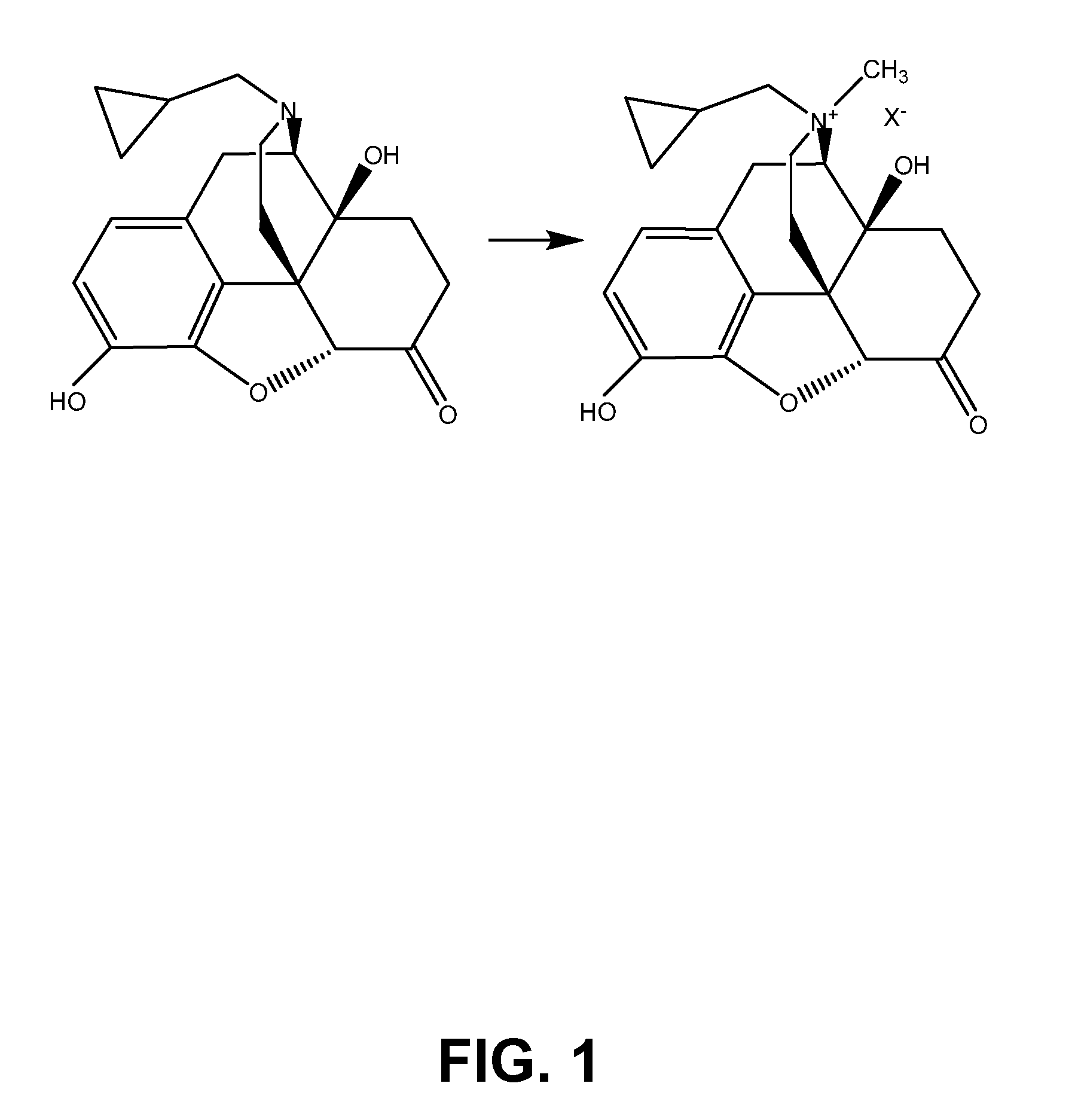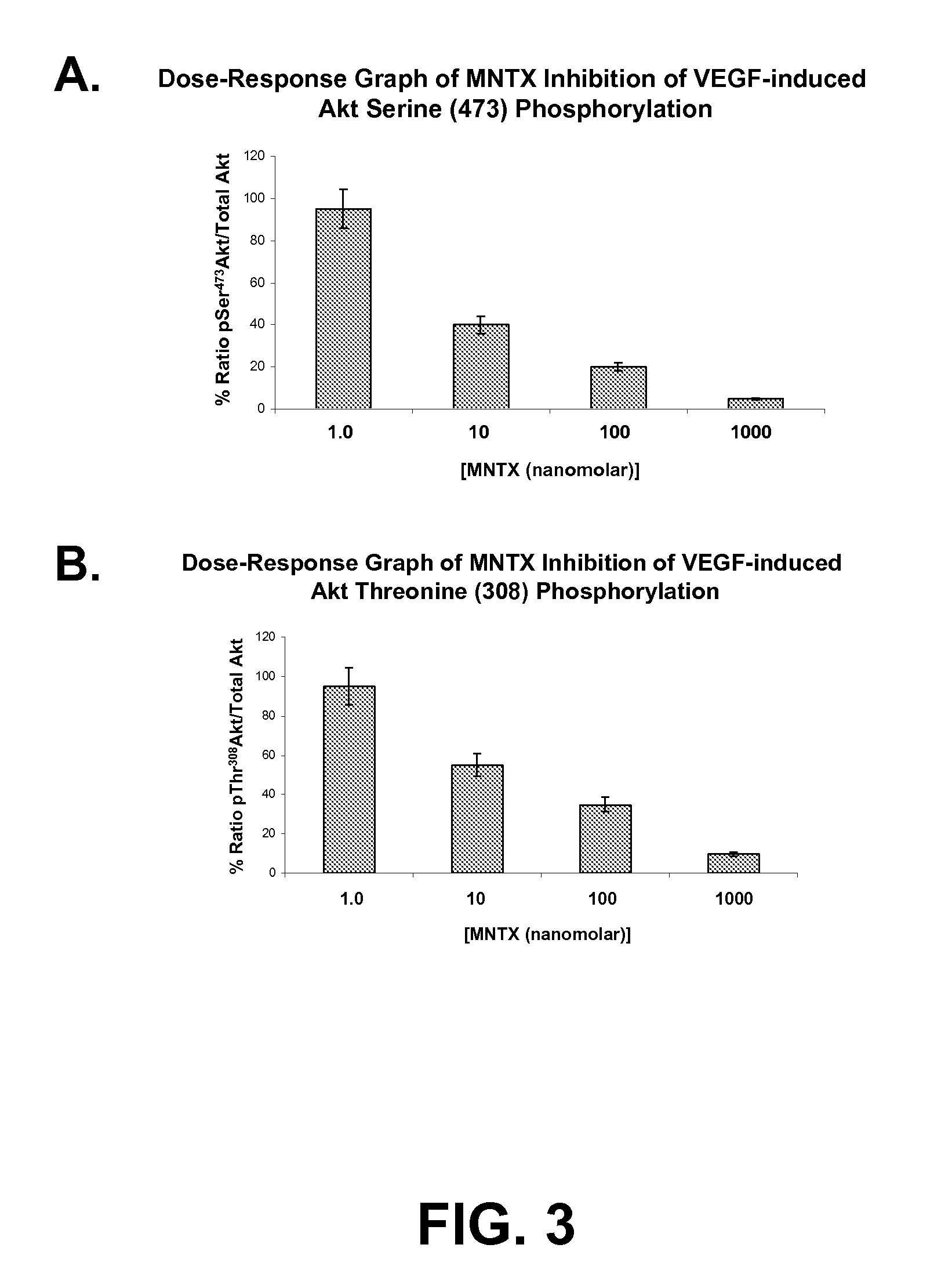Treatment with opioid antagonists and mTOR inhibitors
a technology of opioid antagonists and inhibitors, which is applied in the field of treatment with opioid antagonists and mtor inhibitors, can solve the problems of reducing the high cost of treatment associated with mtor inhibitors, and achieve the effects of reducing the therapeutically effective dose of mtor inhibitors, reducing the incidence and/or severity of adverse reactions, and reducing doses
- Summary
- Abstract
- Description
- Claims
- Application Information
AI Technical Summary
Benefits of technology
Problems solved by technology
Method used
Image
Examples
example 1
Inhibition of VEGF-Induced Akt Activation
[0146]To assess the effects of methylnaltrexone (MNTX) on the VEGF-induced activation of the serine / threonine kinase Akt, a well-characterized endothelial cell line, human pulmonary microvascular endothelial cells (HPMVEC), was used. HPMVEC were serum starved for one hour and either untreated (control) or treated with VEGF (100 nM, 5 minutes) with or without pre-treatment (1 hour) with 100 nM MNTX, 100 ng / ml bevacizumab, 100 μM 5-FU, 100 nM MNTX+100 ng / ml bevacizumab or 100 nM MNTX+100 μM 5-FU. Cell lysates were obtained, run on SDS-PAGE and immunoblotted with anti-pSer473Akt, anti-pThr308Akt, anti-Akt or anti-actin antibody. The results indicated that methylnaltrexone abrogated VEGF-induced phosphorylation of Akt at the serine and threonine at positions 473 and 308, respectively (FIG. 2). Furthermore, methylnaltrexone in combination with bevacizumab and 5-FU synergistically inhibited Akt activation. The effects of various concentrations of M...
example 2
Effect of Rapamycin on VEGF-Induced Endothelial Cell Migration and Proliferation
[0149]To investigate the role of mTOR in cellular migration and proliferation, the effect of rapamycin on HPMVEC migration and proliferation assays was determined. Human EC were assayed for VEGF (100 nM)-induced profileration (FIG. 4) and migration (FIG. 5) in the presence or absence of 0.01, 0.1, 1.0 or 10 nM rapamycin. The results demonstrate that inhibition of mTOR by rapamycin results in a dose-dependent inhibition of endothelial cell proliferation and migration. This is in agreement with previous studies demonstrating that mTOR is involved in these processes.
[0150]Human pulmonary microvascular EC migration assay—Twenty-four transwell units with 8 μM pore size were used for monitoring in vitro cell migration. HPMVEC (˜1×104 cells / well) were plated with various treatments to the upper chamber and VEGF (100 nM) was added to the lower chamber. Cells were allowed to migrate for 18 hours. Cells from the u...
example 3
Synergistic Effect of Methylnaltrexone and mTOR Inhibitors on VEGF-Induced Endothelial Cell Migration and Proliferation
[0153]Given the complex feedback inhibition signaling network that exists between Akt and mTOR, the migration and proliferation assays described above were used to determine whether the simultaneous inhibition of mTOR activation using rapamycin and inhibition of Akt using methylnaltrexone produced a synergistic effect on these processes. Human endothelial cells were assayed for VEGF (100 nM)-induced profileration (FIG. 6) and migration (FIG. 7) in the presence or absence of 10 or 100 nM MNTX, 10 nM naltrexone, 0.1 nM rapamycin, 100 nM MNTX+0.1 nM rapamycin or 10 nM naltrexone+0.1 nM rapamycin. Similar results were obtained with methylnaltrexone in combination with temsirolimus (FIG. 10).
[0154]The results demonstrate that methylnaltrexone and mTOR inhibitors synergistically inhibit the migration and proliferation of endothelial cells. Unlike the results observed for ...
PUM
| Property | Measurement | Unit |
|---|---|---|
| concentration | aaaaa | aaaaa |
| pH | aaaaa | aaaaa |
| volume | aaaaa | aaaaa |
Abstract
Description
Claims
Application Information
 Login to View More
Login to View More - R&D
- Intellectual Property
- Life Sciences
- Materials
- Tech Scout
- Unparalleled Data Quality
- Higher Quality Content
- 60% Fewer Hallucinations
Browse by: Latest US Patents, China's latest patents, Technical Efficacy Thesaurus, Application Domain, Technology Topic, Popular Technical Reports.
© 2025 PatSnap. All rights reserved.Legal|Privacy policy|Modern Slavery Act Transparency Statement|Sitemap|About US| Contact US: help@patsnap.com



